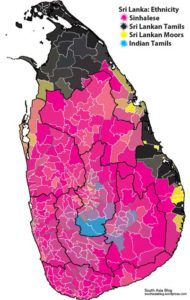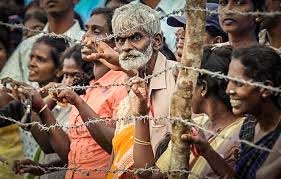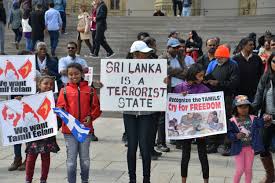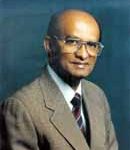Ethnic Cleansing of Tamils in Sri Lanka -a timeline of Buddhist extremism
The learned author explains why Tamils had struggled for Tamil Eelam and how Tamils who were the original inhabitants of Ceylon, now called Sri Lanka, were systematically reduced to second-class citizens in the island nation. The article was first published in The World Sikh News in December 2007. Social scientists need to see this as an aspect of contemporary history as a chapter of Buddhist extremism.
![The learned author explains why Tamils had struggled for Tamil Eelam and how Tamils who were the original inhabitants of Ceylon, now called Sri Lanka, were systematically reduced to second-class citizens in the island nation. The article was first published in The World Sikh News in December 2007. Social scientists need to see this as an aspect of contemporary history as a chapter of Buddhist extremism. In 1948, the very year that the British handed over the Ceylon Government to […]](https://www.theworldsikhnews.com/wp-content/uploads/2019/05/Ethnic-360x270.jpg)
In 1948, the very year that the British handed over the Ceylon Government to the Sinhalese majority on a platter without any safeguards for minorities, the Sinhalese-dominated government passed a law rendering half the Ceylon Tamil population stateless in the land of their birth. Under the Ceylon Citizenship Act, of the nearly two million Tamils in Ceylon, over one million Upcountry Tamils, who had lived in Ceylon for generations, were deprived of their citizenship. To make matters worse, the Sinhalese government disenfranchised these Tamils by depriving them of their voting rights by passing the Ceylon Elections Amendment Act.
The Upcountry Tamil leaders launched a peaceful satyagraha to protest against this racist policy, but it was ignored by the government. The first Prime Minister of Ceylon, D. S. Senanayake -a scheming racist, set the dangerous precedent for others to follow.
Subsequently, there was massive land-grabbing, forcing planned colonization of the traditional homeland of the Tamils in the Northeast by settling Sinhalese from the South. Indigenous Tamils were uprooted and Sinhalese criminals made to reside in Tamil-dominated villages. All protests by Tamils and their leaders were scrupulously ignored.

In 1956, the Sinhalese government passed the Sinhala Only Act, making Sinhala the only official language, divesting official status of the Tamil language. The Tamil language spoken by Tamils and Muslims was the mother tongue of one-third of the people of Ceylon, but it was suppressed. This cultural attack was carried out by Prime Minister Mrs Bandaranayake.
Furthermore, in 1956, Sinhalese mobs attacked and drove out Tamils from their villages in the Gal Oya Valley in the Batticaloa district. This was the commencement of Sinhala mob terrorism against unarmed Tamils. The police were ineffective and remained mute spectators.
The next step in the genocidal programme was to stop employment to Tamils. Those already in the government service were deprived of their increments unless they passed the Sinhala proficiency tests.
In 1957 Tamil leaders signed the Bandaranayake-Chelvanayagam Pact with the Sinhalese government, to devolve power to regional councils, but it was soon unilaterally and dishonestly abrogated. Again in 1965, Tamil leaders signed the Chelvanayagam-Senanayake Pact to devolve power to district councils was also abrogated.
 In 1958 Sinhalese mobs and criminals unleashed terror against the Tamils all over the Sinhalese provinces. Tamils were massacred, their houses burnt, people burnt alive, women raped and tortured. Rendered defenceless, over a 100,000 Tamils fled to their traditional homelands in the Northeast.
In 1958 Sinhalese mobs and criminals unleashed terror against the Tamils all over the Sinhalese provinces. Tamils were massacred, their houses burnt, people burnt alive, women raped and tortured. Rendered defenceless, over a 100,000 Tamils fled to their traditional homelands in the Northeast.
In 1970, by a scheme of standardization, Tamil students were discriminated and barred from higher education. Tamil students were required to score higher marks than the Sinhalese for admission to higher studies.
In the early sixties of the last century, Mrs Srimavo Bandaranayake indulged in the mass deportation of the stateless and disenfranchised Upcountry Tamils to India. The Indian government colluded with the Ceylon government in this move by signing the Srimavo-Sashtri Pact in 1964. Half a million Tamils were forced out of Ceylon to India.
In 1974 the Sinhala state unleashed police violence against the Tamils who had gathered to hold the Tamil Research Conference in Jaffna, killing nine and wounding many. In 1976 the Sinhalese police opened fire at a mosque killing many Tamil-speaking Muslims.
In 1977 the UNP government of Prime Minister J.R. Jayawardena unleashed mob violence against the Tamils particularly in the plantations, killing hundreds of innocent people. Nearly 40,000 Tamils were made refugees and destitute and many fled to India. Nearly 100 Hindu temples were destroyed with the active involvement of Sinhalese politicians.
In 1978 the Sri Lankan Parliament enacted the notorious Prevention of Terrorism Act and armed forces were given a free hand to kill Tamil youth. Torture camps were set up and Tamils disappeared involuntarily in large numbers. The government unleashed the Sinhalese and Muslim home-guards to oppress Tamils.

In 1981, the Sinhalese armed forces rampaged in Jaffna, killing and setting fire to buildings including the historic Jaffna Public Library containing 94,000 invaluable books. This act of cultural genocide was carried out by two Sinhala ministers, Athulathmudali and Cyril Mathew, who were present in Jaffna at the time of the attack. The Sinhalese government chased out Tamils from their villages in large numbers in the Northeast and replaced them with the Sinhalese from the South. Plantation Tamils, who had taken refuge in Northeast due to Sinhala terror, were forcibly put into buses and dumped in the Central Province. Tamil students in the University of Peradeniya were also attacked. Tamils were arrested in large numbers and held without trial for long periods. Many were tortured and many disappeared, obviously involuntarily. In the Welikade jail, many Tamil prisoners were killed in July 1983.
The devastation to the Sri Lankan Tamil people caused by the Sinhalese pogrom reduced the Tamil population to 30 per cent of what it was in 1948. It is time that the Sinhalese accused are tried for genocide and crimes against humanity.
This reign of terror continued during the tenure of J.R. Jayawardena, Premadasa, and Chandrika Kumaratunga. The Sinhala armed forces continued a reign of state terror. Mass arrests, killings, disappearances, torture, rape, burning of houses, destruction of schools, hospitals, businesses, shops, temples and churches rendered Tamils destitute. Tamil villages were bulldozed and the army followed a scorched-earth policy in the Tamil homeland.
In the village of Manalaru, where the Tamils were uprooted, it was renamed Welioya, and Sinhalese convicts were settled. Jaffna, Palali, Nedunthivu, Manalaru, Valvettiturai, Kilali, Trincomalee, Batticaloa, Kokkadicholai, Mannar, Bidunuwewa, Kanchirankuda have suffered the most. Tamils were massacred and buried in mass graves in Chemmani. It is disgusting to note that some of the gross violators of human rights have been rewarded with ambassadorships.
The Sinhala government imposed an economic embargo on Tamil provinces preventing supply of food, clothing, and medicines, building materials, fuel and other basic necessities. People were dying, but international bodies were denied access.
According to an estimate, some 800,000 Tamils have fled from Sri Lanka to India, U.K., Europe, North America, Australia and Africa. One million Tamils have been displaced internally and most of them have become homeless. A large number of children have been orphaned and many more have been maimed.
Even after years of the cease-fire, Sinhalese armed forces occupied Tamil homes, hospitals, schools, places of worship and public places in many provinces. The Sinhalese police and army were guilty of sadistic torture of Tamil girls and women. There was forced sterilization of Plantation Tamils. Due to abject poverty, a large number of Tamil children are employed in Sinhalese homes as domestic servants and are subjected to abuse. The culprits escaped punishment due to state patronage and a biased judiciary.
According to an estimate, some 800,000 Tamils have fled from Sri Lanka to India, U.K., Europe, North America, Australia and Africa. One million Tamils have been displaced internally and most of them have become homeless. A large number of children have been orphaned and many more have been maimed.
The devastation to the Sri Lankan Tamil people caused by the Sinhalese pogrom reduced the Tamil population to 30 per cent of what it was in 1948. It is time that the Sinhalese accused are tried for genocide and crimes against humanity.
 S. Makenthiran is a graduate of the University of Ceylon, Colombo and a Fellow of the Chartered Association of Certified Accountants of UK. He has served in Sri Lanka and different countries in Africa including Zambia, Malawi and Botswana. He was a World Bank Project Finance Officer, before immigrating to Canada. In Canada he works as an accountancy, financial and tax consultant.
S. Makenthiran is a graduate of the University of Ceylon, Colombo and a Fellow of the Chartered Association of Certified Accountants of UK. He has served in Sri Lanka and different countries in Africa including Zambia, Malawi and Botswana. He was a World Bank Project Finance Officer, before immigrating to Canada. In Canada he works as an accountancy, financial and tax consultant.
